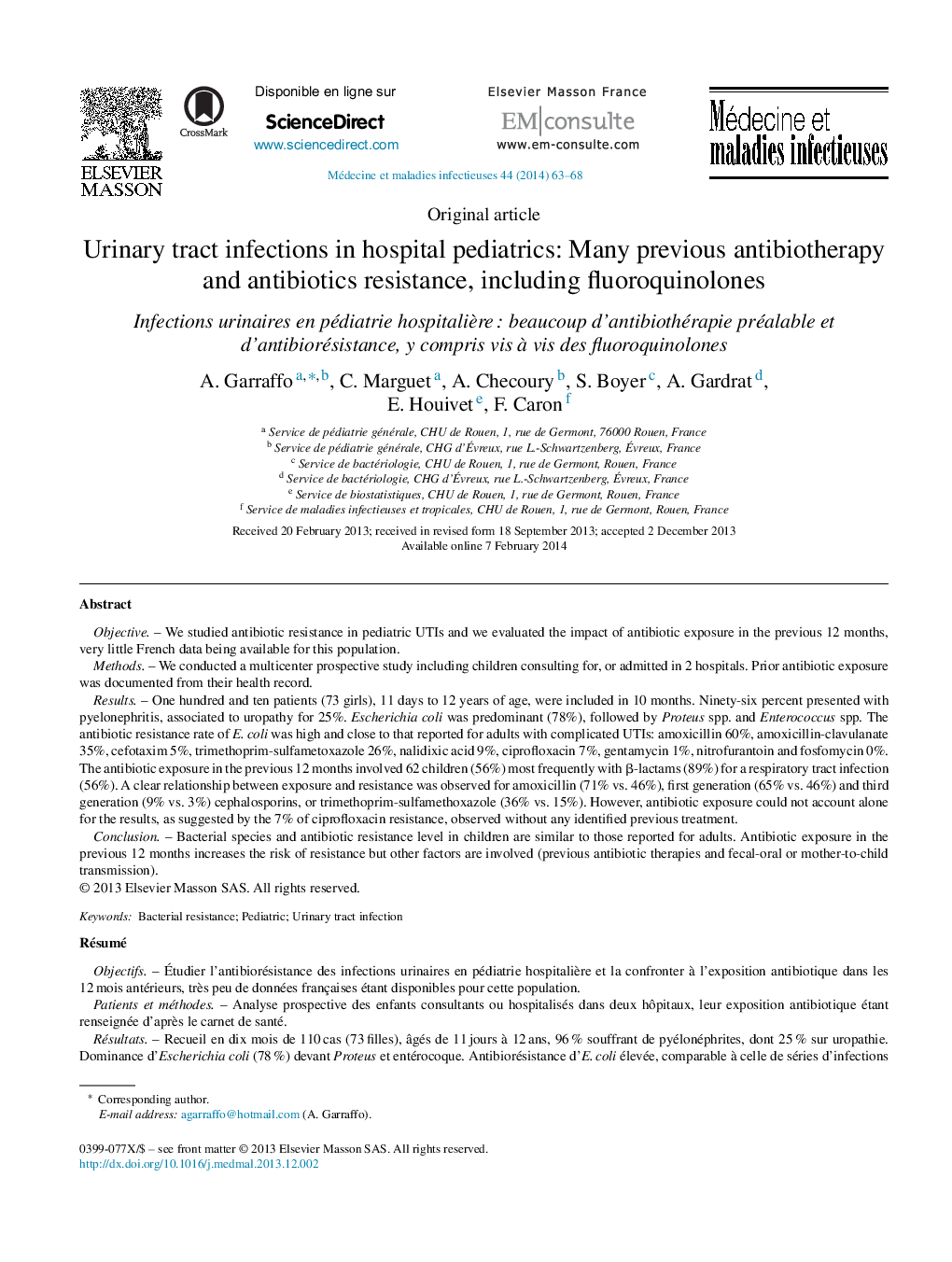| کد مقاله | کد نشریه | سال انتشار | مقاله انگلیسی | نسخه تمام متن |
|---|---|---|---|---|
| 3412924 | 1224254 | 2014 | 6 صفحه PDF | دانلود رایگان |
ObjectiveWe studied antibiotic resistance in pediatric UTIs and we evaluated the impact of antibiotic exposure in the previous 12 months, very little French data being available for this population.MethodsWe conducted a multicenter prospective study including children consulting for, or admitted in 2 hospitals. Prior antibiotic exposure was documented from their health record.ResultsOne hundred and ten patients (73 girls), 11 days to 12 years of age, were included in 10 months. Ninety-six percent presented with pyelonephritis, associated to uropathy for 25%. Escherichia coli was predominant (78%), followed by Proteus spp. and Enterococcus spp. The antibiotic resistance rate of E. coli was high and close to that reported for adults with complicated UTIs: amoxicillin 60%, amoxicillin-clavulanate 35%, cefotaxim 5%, trimethoprim-sulfametoxazole 26%, nalidixic acid 9%, ciprofloxacin 7%, gentamycin 1%, nitrofurantoin and fosfomycin 0%. The antibiotic exposure in the previous 12 months involved 62 children (56%) most frequently with β-lactams (89%) for a respiratory tract infection (56%). A clear relationship between exposure and resistance was observed for amoxicillin (71% vs. 46%), first generation (65% vs. 46%) and third generation (9% vs. 3%) cephalosporins, or trimethoprim-sulfamethoxazole (36% vs. 15%). However, antibiotic exposure could not account alone for the results, as suggested by the 7% of ciprofloxacin resistance, observed without any identified previous treatment.ConclusionBacterial species and antibiotic resistance level in children are similar to those reported for adults. Antibiotic exposure in the previous 12 months increases the risk of resistance but other factors are involved (previous antibiotic therapies and fecal-oral or mother-to-child transmission).
RésuméObjectifsÉtudier l’antibiorésistance des infections urinaires en pédiatrie hospitalière et la confronter à l’exposition antibiotique dans les 12 mois antérieurs, très peu de données françaises étant disponibles pour cette population.Patients et méthodesAnalyse prospective des enfants consultants ou hospitalisés dans deux hôpitaux, leur exposition antibiotique étant renseignée d’après le carnet de santé.RésultatsRecueil en dix mois de 110 cas (73 filles), âgés de 11 jours à 12 ans, 96 % souffrant de pyélonéphrites, dont 25 % sur uropathie. Dominance d’Escherichia coli (78 %) devant Proteus et entérocoque. Antibiorésistance d’E. coli élevée, comparable à celle de séries d’infections urinaires compliquées de l’adulte : amoxicilline 60 %, amoxicilline-clavulanate 35 %, céfotaxime 5 %, cotrimoxazole 26 %, acide nalidixique 9 %, ciprofloxacine 7 %, gentamicine 1 %, nitrofurantoïne et fosfomycine 0 %. L’exposition antibiotique dans les 12 mois antérieurs concernait 62 enfants (56 %), majoritairement par β-lactamines et pour infection respiratoire (89 % et 56 % des exposés, respectivement), avec une nette corrélation entre l’exposition antibiotique et l’antibiorésistance d’E. coli à l’amoxicilline (71 % vs 46 %), les C1G (65 % vs 46 %), les C3G (9 % vs 3 %) et le cotrimoxazole (36 % vs 15 %). Cependant, l’exposition antibiotique n’expliquait pas tout (7 % de résistance à la ciprofloxacine sans traitement préalable identifié).ConclusionLes espèces bactériennes et niveaux d’antibiorésistance chez l’enfant sont similaires à ceux actuellement observés en France chez l’adulte. L’exposition antibiotique dans les 12 mois majore le risque de résistance, mais d’autres facteurs sont en cause (rôle probable des traitements plus anciens et de la contamination oro-fécale, voire materno-fœtale pour les plus jeunes).
Journal: Médecine et Maladies Infectieuses - Volume 44, Issue 2, February 2014, Pages 63–68
